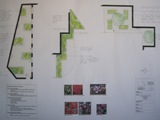This is an interesting low budget project around a new public building, the garden spaces are to be looked at by users of the building rather than to be sat in. Environmental benefits of the design include:
Use of recycled materials
- Screened, recycled topsoil (& recycled crushed concrete) to make up levels / replace that taken from site during construction
- Organic woodchip mulch to naturally control and deter weeds
Use of natural materials
- Softwood sleepers (FSC certified) to define the beds / design throughout the winter months
- Plants chosen to attract and support wildlife (e.g. insects and birds)
Plants have been selected to offer
- A long season of flowering (repeat flowering Rosa de Rescht, Cyclamen coum, C. hederifolium and Pyracantha)
- Scent over a long season (Rosa de Rescht)
- Food for wildlife (berries, nectar & pollen)
- Winter interest (Cyclamen, Pyracantha and Malus ’Red Sentinel’)
- Habitat for wildlife (trees and wall trained Pyracantha)
Attracting wildlife
- According to the BUGS survey at Sheffield University trees contribute significantly to biodiversity in an urban setting e.g. habitat, food, shelter. Two trees have been incorporated into the design
- Wall shrubs provide habitat, food, shelter, nesting sites
- Willow wall mounted sculpture – my outdoor willow sculptures frequently attract nesting birds
Design relating to the local landscape
Malus ‘Red Sentinel’, a crab apple, links to the cider tradition of the area
The willow sculpture is made from Somerset willow
